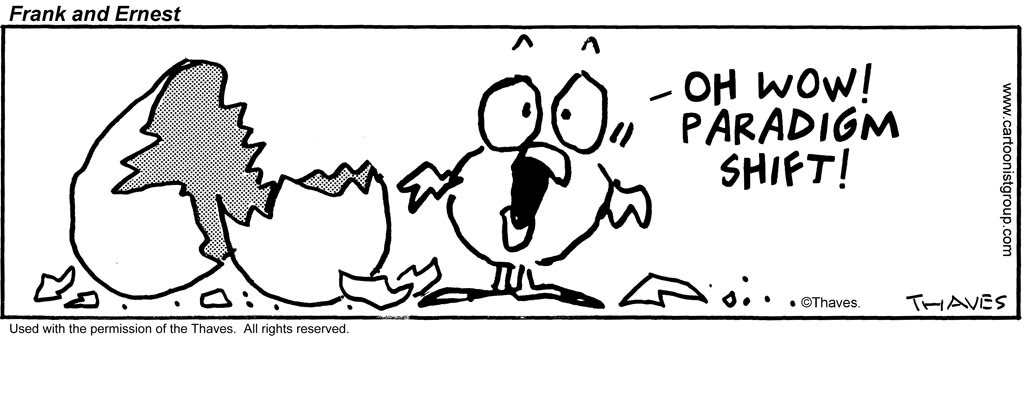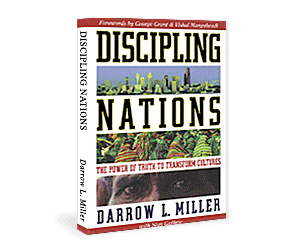Eric Metaxas, author and worldview observer, recently wrote an article on Breakpoint (Not Sermons but Stories) on a topic near and dear to us here at Darrow Miller and Friends. He wrote about the influence and driving power of worldview on the artist and on the power of the artist to promote worldview. It is the idea of the balladeer.
Darrow introduced this topic in various seminars and teachings discussing how ideas penetrate societies (cultures). He describes the artist as the first step in the movement of an idea from the academics and philosophers into the rest of society. Darrow presented a paper at a 2003 YWAM gathering titled Worldview and Art: A Call for Balladeers. This idea is a frequent topic at Darrow Miller and Friends.
Metaxas makes a valid point that the balladeer’s work flows from his worldview. He further asserts that ideas, when they are consistent with the artist’s worldview (their ‘story’), more readily shape culture than the same ideas presented for the sake of the idea (a ‘sermon’).
We here at DMF had two reactions to this. The first is that a good sermon does more than just present us a good idea or good theology; it will move us to a reaction. The second is that there is something deeper to the power of the balladeer than just art that flows from (and thus promotes) the artists’ worldview.
Gary Brumbelow, who manages the DMF blog, best expressed the first reaction in an email discussion with Darrow and me:
I think I understand what [Metaxas] means by “not sermons” but I believe he misses an important distinction. A sermon is not, by definition, “pushing a message.” Many sermons are that in practice, but the best sermons are those that draw the hearer to the beauty of Christ. Thomas Chalmers (1780-1847) wrote a sermon, “The Expulsive Power of a New Affection,” in which he makes the point that people do not give up their pet vices, unbelief, etc., by someone trying to force them to let go. Sermons (or messages of any description) like that are counterproductive.
“A man will no more consent to the misery of being without an object, because that object is a trifle, or of being without a pursuit, because that pursuit terminates in some frivolous or fugitive acquirement, than he will voluntarily submit himself to the torture, because that torture is to be of short duration. … the present desire [of the unbeliever, e.g.] is not be got rid of simply by destroying it. It must be by substituting another desire … and the most effectual way of withdrawing the mind from one object is not by turning it away upon desolate and unpeopled vacancy, but by presenting to its regards another object still more alluring. ”
My ambition is to preach Christ as the One who captures all the purity of joy and delight and desire that people seek in some other framework and find, ultimately, only ashes.
Gary’s phrase “the best sermons are those that draw the hearer to the beauty of Christ” reminds me of a passage of J.R.R. Tolkien (which Darrow quotes in his balladeer paper) concerning good fantasy.[1] Tolkien says we most readily find beauty in the fantasy (‘fairy tale’) when the world of the fantasy most accurately reflects (or reveals) reality. The reader readily responds with joy to what Tolkien calls “a far-off gleam or echo of evangelium in the real world.” Or, as Darrow writes,
C.S. Lewis summarizes it well: “…an author should never conceive of himself as bringing into existence beauty or wisdom which did not exist before, but simply and solely as trying to embody in terms of his own art some reflection of that eternal Beauty and Wisdom.”[2]
While it is true that the craft of a balladeer flows from his worldview, there is something else at work as well. Often, a good artist, actor, writer, or musician can powerfully present something from a worldview not his own. Consider, for example, Victor Hugo’s Les Miserables, Michelangelo’s Sistine Chapel, or the music of Beethoven and Mozart. It’s one thing for an artist to effectively portray the perspective of his own worldview. But how can we explain the power of art (such as the above examples) even when it is not rooted in the artist’s worldview? The answer is found in the truth of an objective reality that we all yearn to understand and relate to.
We apprehend objective reality through revelation and reason. Revelation (both the general revelation of creation and the specific revelation of scripture) is apprehended by experience, through the physical and spiritual senses. Reason is the analytical examination and synthesis of truth, ideas, and concepts. The human brain is wired to receive and process information in images (truth ‘revealed’ and experienced) in our “right brain” (the artistic side) and then develop and understand that information through reason in our “left brain” (the analytical side). Stories speak to us through image, sermons through rhetoric and logic. Both, when done well, move us to a response. Stories speak to the mind through the heart. Sermons move the heart through the mind. They both move us toward the worldview of the balladeer or the preacher.
Writers on this page have often discussed the goal of biblical transformation as moving us toward Beauty, Truth, and Goodness. It is here that we see the wonderful interplay of stories and sermons from those rooted in the biblical paradigm. The psalmist writes in Psalm 119; 11 & 15: “I have hidden your word in my heart, that I might not sin against you. … I meditate on your precepts and consider your ways.” The Christian balladeer, through his art, reveals Beauty, which leads us to ponder Truth and respond with Goodness. The preacher declares Truth, through which we see Beauty and respond with Goodness.
Stories and sermons are two sides of the same coin, two ways of understanding and connecting with Reality. There is a hunger within the human psyche to understand reality, to connect with truth, to see beauty, and to be good.
One story that powerfully does this is Les Miserables. But that’s for another post.
– Bob Evans

Bob Evans is Administrative Director of Global Network Ministries, Inc., and serves as secretary of the Board of Directors of Disciple Nations Alliance. He has travelled extensively in Asia and around the world serving local church movements and leading ministry and development teams from the U.S. Bob has four children and two grandchildren, and resides in Laguna Niguel, California.






4 Comments
Sam Smith, Managing Editor of the Worldview Church --Colson Center for Christians Worldview
January 21, 2013 - 11:25 amHey Bob,
Great observations, and we’ll pass them along to the Break-Point Content team (and Eric Metaxas, too). I would like to place your article on our website and see if Eric would response. Please email me and send me a bio.
We are looking forward to have Darrow with us at the Wilberforce this April!
Sam Smith
Karen Pelt
January 28, 2013 - 9:00 pmWOW folks. I so look forward to reading Darrow Miller and Friends when it shows up in my email. Although I have been a christian most of my 68 years, since I was introduced to Darrow’s writings and more on biblical worldview, I feel a little like Alice falling through the looking glass. My whole world is being restructured. Thank you for continuing to inform and challenge us. Your blog offers a better alternative for seeing the world through the eyes of God.
admin
January 29, 2013 - 2:20 pmKaren, thanks for such a powerful testimony! We are very happy to know our blog has been helpful to you.
Gary Brumbelow